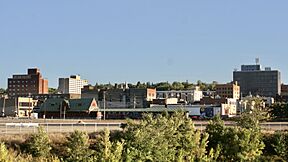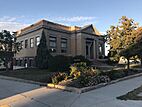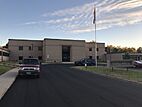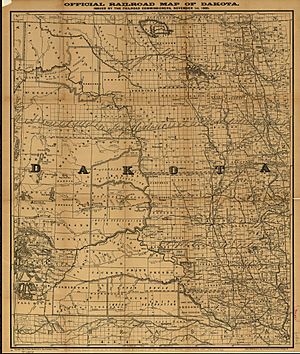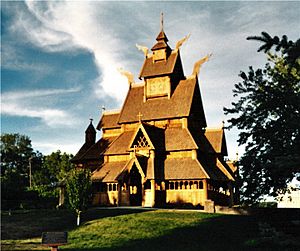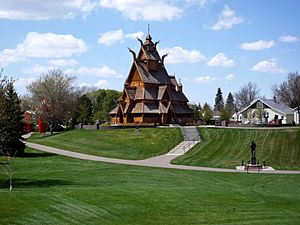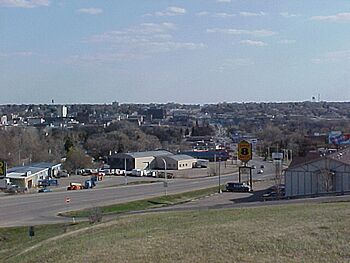Minot, North Dakota facts for kids
Quick facts for kids
Minot, North Dakota
|
||
|---|---|---|
|
Downtown Minot
Milton Young Towers
Minot Public Library
St. Leo the Great Roman Catholic Church
Minot Carnegie Library
Minot City Hall
|
||
|
||
| Nickname(s):
"The Magic City"
|
||
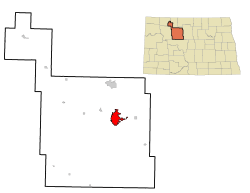
Location of Minot in Ward County
|
||
| Country | United States | |
| State | North Dakota | |
| County | Ward | |
| Founded | 1886 | |
| Incorporated | July 16, 1887 | |
| Area | ||
| • City | 27.734 sq mi (71.831 km2) | |
| • Land | 27.701 sq mi (71.744 km2) | |
| • Water | 0.033 sq mi (0.085 km2) | |
| Elevation | 1,549 ft (472 m) | |
| Population
(2020)
|
||
| • City | 48,377 | |
| • Estimate
(2023)
|
47,373 | |
| • Rank | US: 850th ND: 4th |
|
| • Density | 1,710.43/sq mi (660.41/km2) | |
| • Urban | 50,925 (US: 498th) | |
| • Metro | 75,742 (US: 382nd) | |
| Demonym(s) | Minoter | |
| Time zone | UTC–6 (Central (CST)) | |
| • Summer (DST) | UTC–5 (CDT) | |
| ZIP Codes |
58701, 58702, 58703, 58704, 58705, 58707
|
|
| Area code(s) | 701 | |
| FIPS code | 38-53380 | |
| GNIS feature ID | 1036165 | |
| Highways | US 2, US 52, US 83, US 83 Byp. | |
| Sales tax | 7.5% | |
Minot (![]() i/ˈmaɪnɒt/ MY-not) is a city in North Dakota, United States. It is the main city of Ward County. Minot is famous for the Minot Air Force Base, which is about 15 miles north of the city.
i/ˈmaɪnɒt/ MY-not) is a city in North Dakota, United States. It is the main city of Ward County. Minot is famous for the Minot Air Force Base, which is about 15 miles north of the city.
In 2020, Minot had a population of 48,377 people. This makes it the fourth-largest city in North Dakota. It is also an important trading center for northern North Dakota and parts of Canada. Minot was founded in 1886 when the Great Northern Railway was being built. It quickly grew, earning it the nickname "Magic City."
Minot is the main city of the Minot metropolitan area. This area includes McHenry, Renville, and Ward counties. In 2020, this larger area had a population of 77,546 people.
Contents
History of Minot
Minot started in 1886 because of the Great Northern Railway. The railway stopped building for the winter near a place called Gassman Coulee. Because it was the end of the line, a "tent town" quickly appeared. It grew almost overnight, like magic! This is how Minot got its nickname, "Magic City." In just five months, the population grew to over 5,000 people.
The railroad chose the town's location on land owned by Erik Ramstad. He agreed to give up his land and became one of the city's early leaders. The town was named after Henry D. Minot, who was a railroad investor and a friend of James J. Hill, the railway builder.
Minot became an official city on June 28, 1887. Later, another railway, the Minneapolis, St. Paul and Sault Ste. Marie Railroad (Soo Line), built a line to Minot in 1893.
In the 1950s, Minot grew a lot with money from the government. This money helped build the Minot Air Force Base (1956–57) and the Garrison Dam (1947–53) on the Missouri River.
In 1969, a big flood from the Souris River caused a lot of damage. After this, the Army Corps of Engineers changed the river's path and built flood control structures.
On January 18, 2002, a train accident happened west of Minot. It released a large cloud of a gas called anhydrous ammonia. One person died, and many people in Minot and Burlington became sick or were hurt. This was one of the worst chemical accidents in the country.
In 2011, the 2011 Souris River flood caused even more damage. About 12,000 people had to leave their homes. The river reached a record high level. It's thought that 20% of Minot was damaged by the flood. Over 4,100 homes were affected, and many were badly damaged or destroyed.
Geography of Minot
Minot covers an area of about 17.45 square miles. Most of this area is land, with only a small amount of water.
Minot's Neighborhoods
Minot is usually divided into three main areas:
- North Hill: This area is generally north of Eleventh Avenue North.
- Souris River Valley: This area includes neighborhoods like Downtown, Eastwood Park, and Oak Park.
- South Hill: This is a large area south and west of Valley Street.
Minot's Location
Minot is located in the northwestern part of North Dakota. The Souris River, also called the Mouse River, flows through the city from west to east.
Minot is a central trading hub for nearby cities. These include Burlington, Velva, Garrison, and Stanley.
The city is mostly land. The Souris River and its small lakes make up a very small part of the city's total area. The valley where the city sits is about 160 feet lower than the flat plains around it.
City Layout and Addresses
Minot uses a grid system for its streets. Streets run north-south, and avenues run east-west. Streets are numbered based on how far they are from Main Street. Avenues are numbered based on how far they are from Central Avenue. This system helps to easily find any address in the city.
The Souris River
The Souris River divides Minot into northern and southern parts. The land rises up from the river valley to flat plains on both sides. The area north of the river is called North Hill, and the area south of it is called South Hill.
Minot's Population
| Historical population | |||
|---|---|---|---|
| Census | Pop. | %± | |
| 1890 | 575 | — | |
| 1900 | 1,277 | 122.1% | |
| 1910 | 6,188 | 384.6% | |
| 1920 | 10,476 | 69.3% | |
| 1930 | 16,099 | 53.7% | |
| 1940 | 16,577 | 3.0% | |
| 1950 | 22,032 | 32.9% | |
| 1960 | 30,604 | 38.9% | |
| 1970 | 32,290 | 5.5% | |
| 1980 | 32,843 | 1.7% | |
| 1990 | 34,544 | 5.2% | |
| 2000 | 36,567 | 5.9% | |
| 2010 | 40,888 | 11.8% | |
| 2020 | 48,377 | 18.3% | |
| 2023 (est.) | 47,373 | 15.9% | |
| U.S. Decennial Census 2020 Census |
|||
In 2022, Minot had about 21,161 households. The average household had 2.21 people. The median household income was $75,545. About 11.3% of the people in Minot live below the poverty line. Most adults in Minot have a high school diploma, and many have a college degree.
The most common backgrounds reported by people in Minot are English, Spanish, Indo-European, and Asian. The average age in the city is 33.0 years old.
2020 Census Details
In 2020, Minot had 48,377 people. Most residents (85.1%) were White. Other groups included African American (4.2%), Native American (2.3%), and Asian (2.3%). About 6.3% of the population was Hispanic or Latino.
There were 20,979 households. About 26.3% of these households had children under 18. The average household size was 2.24 people. The average age in the city was 33.8 years.
Minot's Economy
Minot's economy is strongly connected to the Minot Air Force Base. This base is about 13 miles north of the city. Because of the base, Minot's economy is stronger than other cities of its size.
Major Employers in Minot
Here are some of the largest employers in Minot:
| # | Employer | # of Employees |
|---|---|---|
| 1 | Minot Air Force Base | 12,123 |
| 2 | Trinity Health | 2,850 |
| 3 | Minot Public Schools | 1,047 |
| 4 | Minot State University | 561 |
| 5 | City of Minot | 437 |
| 6 | Hess | 380 |
| 7 | Cognizant (ING Minot Service Center) | 372 (2018) |
| 8 | Delta Vacations | 367 |
| 9 | Ward County | 367 |
| 10 | MLT Inc. | 366 (2019) |
| 11 | Marketplace Foods | 313 (2020) |
| 12 | Kalix (MVAW) | 279 |
| 13 | BNSF Railroad | 230 |
| 14 | Grand Hotel/International Inn | 219 (2018) |
| 15 | Ryan Family Dealerships | 204 (2020) |
| Total | 18,641 |
Minot has also seen growth from oil drilling in the Bakken Formation. This has brought more people and new buildings to the area.
Arts and Culture in Minot
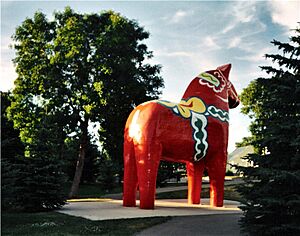
Minot has a lively arts scene. It includes an art museum, a symphony orchestra, and various dance and theater groups. More than 40 organizations are part of the Minot Area Council on the Arts.
Many people in Minot have Scandinavian family backgrounds. Every October since 1977, Minot hosts the Norsk Høstfest. This is North America's largest festival celebrating Scandinavian-American culture.
The Scandinavian Heritage Park is also in Minot. It has reminders and copies of things from Norway, Sweden, Denmark, Finland, and Iceland.
Places to Visit in Minot
- Arlene Theater: A place for performing arts, where the Mouse River Players perform.
- Dakota Territory Air Museum: An aircraft museum near the airport with many war and civilian planes.
- Maysa Arena: A year-round facility for skating with three ice rinks.
- Scandinavian Heritage Park: Home to the Minot Visitor's Center and buildings inspired by Scandinavian architecture, including a Stave Church.
- Old Soo Depot Transportation Museum: A museum in the old 1912 Soo Line Depot.
- North Dakota State Fair Center: Hosts many large events like the North Dakota State Fair and the Norsk Høstfest. It also holds rodeos and college hockey games.
- Roosevelt Park and Zoo: A popular park with a zoo.
- Taube Museum of Art: Located in a historic bank building, it features changing art exhibits.
Sports in Minot
Minot is home to several sports teams and venues:
- The Minot Hot Tots: A baseball team in the Northwoods League that plays at Corbett Field.
- The Minot Minotauros: An NAHL hockey team that plays at Maysa Arena.
- The Minot State Beavers: College sports teams that play ice hockey, baseball, football, and basketball at various city venues.
- The Mouse River Rollers: A roller derby team.
Minot has several public sports places, including All Seasons Arena, Corbett Field, Maysa Arena, and the Minot Municipal Auditorium.
Parks and Recreation
The Minot Park District manages 17 parks with different facilities. These include:
- Corbett Field: Used for baseball.
- Optimist soccer complex.
- MAYSA ice arena.
- Sertoma Complex: Has 8 softball fields.
- Souris Valley Golf Course.
- An indoor tennis complex.
The biggest parks are Roosevelt Park and Oak Park. The Roosevelt Park Zoo is one of the best zoos in the area. There is also a "bark park" for dogs.
The North Dakota State Fair happens every July in Minot.
Education in Minot
Minot has a public school system and private schools.
Public Schools
The Minot Public Schools system has:
- Ten elementary schools (Kindergarten to 5th grade) in the city.
- Two elementary schools (Kindergarten to 6th grade) on the Minot Air Force Base.
- Four middle schools (6th to 8th grade). Three are in Minot (Jim Hill, Erik Ramstad, Central Middle School). One is on Minot AFB (Memorial Middle School).
- Two public high schools: Minot High School and Minot North High School.
- An adult learning center and Souris River Campus, which is an alternative high school.
Private Schools
Private schools in Minot include:
- Bishop Ryan Catholic School: Offers preschool through 12th grade.
- Our Redeemer's Christian School: A Protestant school for Kindergarten through 12th grade.
Higher Education
Minot is also home to Minot State University. This is the third-largest university in North Dakota. It started as a teacher's college in 1913 and became a university in 1987.
Media in Minot
Minot has several ways to get news and entertainment. These include TV stations, radio stations, and newspapers.
Television Stations
Minot has six television stations:
- KSRE (PBS)
- KMOT (NBC, Fox, Me-TV)
- KXMC-TV (CBS, The CW)
- KMCY (ABC)
- KNDM (Heroes & Icons)
Radio Stations
Minot has 15 radio stations (3 AM, 12 FM). They play different types of music and shows, like country, classic hits, Top 40, rock, and Christian music. Some stations are local, while others are part of larger networks.
Newspapers
The main local newspaper is the Minot Daily News, which is published six days a week. The Minot Air Force Base has its own weekly newspaper called The Northern Sentry. Minot State University students publish a newspaper called Red & Green once a week during the school year.
Transportation in Minot
Railroads
The railroads that helped build Minot are still here. The Great Northern Railway is now part of BNSF Railway. The Soo Line is now run by Canadian Pacific Kansas City.
You can travel by train on Amtrak's Empire Builder line. This train connects Chicago with Portland and Seattle. It stops at the Minot Amtrak station every day.
Highways
Three major U.S. highways go through Minot:
- US 2: Runs east-west.
- US 52: Runs southeast-northwest.
- US 83: Runs north-south through central Minot.
These highways connect Minot to Canada, Montana, and other major roads. There is also the Minot Bypass that goes around parts of the city.
Airport
Minot International Airport has flights from three airlines. It also offers charter and air taxi services.
Local Transit
Local bus service in Minot is provided by Minot City Transit.
Notable People from Minot
Many interesting people have connections to Minot:
- Dale Brown (born 1935): A famous basketball coach for LSU.
- Jonny Craig (born 1986): A singer.
- Josh Duhamel (born 1972): An actor.
- Gary Johnson (born 1953): A former governor of New Mexico.
- Wiz Khalifa (born 1987): A rapper, singer, and actor, born at the Minot Air Force Base.
- Kevin Miller (born 1977): A voice actor.
- Greg Raymer (born 1964): A professional poker player.
- Donny Schatz (born 1977): A sprint car racing driver.
Sister Cities
Minot has special "sister city" relationships with two other cities:
- Skien, Norway: This connection reflects the strong Norwegian heritage in Minot.
- Moose Jaw, Saskatchewan, Canada: This city is about 300 miles northwest of Minot. They share many similarities, like their size, location in river valleys, and air force bases.
See also
 In Spanish: Minot (Dakota del Norte) para niños
In Spanish: Minot (Dakota del Norte) para niños


